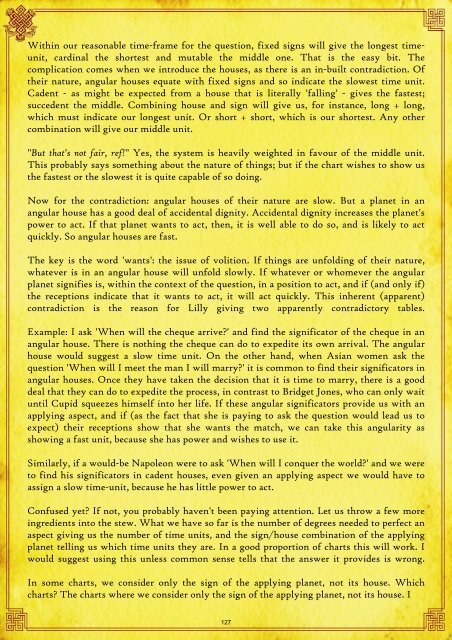days, weeks, months, years, whatever. But sometimes we will assume that Mars stands stilland take only the distance between the planets' present positions, giving us just 4 degreesand so 4 days, weeks, months, etc.So how do I know when to go for the true aspect and when to go for the transit? I don'tknow. I have not found any reliable guidelines in either the texts or in practice. I wouldsuggest that the only guide is that in many cases one answer will make sense within thecontext of the question, while the other will not. I suggest that this is what we see Lillydoing in various of his judgments - bouncing possibilities off the client, or off his ownknowledge of the realities of the situation.Suppose we ask 'When will the King be executed?' and find that the transit-type judgmentgives us 3 days and the perfection-type gives us 6. We might know that the trial has yet tofinish, and when it does it will take time to build the scaffold and organize the hot-dogconcessions. 6 days would make better sense.The golden rule in all matters of timing, as in all else in astrology, is that we do not have tobe perfect. We are allowed to judge, "It might be in three days; but weighing all the evidenceI think it more likely to be in six."We have a piece of music; we must allow ourselves to play. We can swing it or we can playit straight: we are still playing. The one vital point is that we learn our scales, else we cannotplay at all.So: we have our number of time units; we now need to work out which is the appropriateunit. Lilly brings nothing but confusion here. First, he gives two contradictory scales oftiming; second, he pins both to fixed units. The suggestion that, for instance, angular houses= years is most unhelpful. Suppose our question is "When will my boyfriend phone?"; 'years'is not a relevant concept. So put Lilly away and listen up.Any question carries its own time-frame, which will have a short, a medium and a longpossibility. For the love-struck teenager demanding 'When will my boyfriend phone?'minutes as short, hours as medium and days as long might be the options. For the olderquerent asking 'When will I meet Mr. Right?' years must be the longest option, givingmonths as medium and weeks as short. The three units will follow one from the other: wedo not have minutes, months and years."Yes, but this assumed time-frame limits the possibilities of what the chart can tell us." No, itdoesn't. We can have perfection in less than one degree, so our decision that years, monthsor weeks is the reasonable range of choice for 'When will I meet Mr. Right?' does not clipCupid's wings. A perfection at less than one degree on our fastest option could still give us'This afternoon!'To decide which of our time units we shall choose, we consider the sign and the house inwhich our applying planet stands. Ignore the sign and house in which the planet applied tostands. No, I know you weren't listening: ignore the sign and house in which the planetapplied to stands. Even if you like the look of them, ignore them!126
Within our reasonable time-frame for the question, fixed signs will give the longest timeunit,cardinal the shortest and mutable the middle one. That is the easy bit. Thecomplication comes when we introduce the houses, as there is an in-built contradiction. Oftheir nature, angular houses equate with fixed signs and so indicate the slowest time unit.Cadent - as might be expected from a house that is literally 'falling' - gives the fastest;succedent the middle. Combining house and sign will give us, for instance, long + long,which must indicate our longest unit. Or short + short, which is our shortest. Any othercombination will give our middle unit."But that's not fair, ref!" Yes, the system is heavily weighted in favour of the middle unit.This probably says something about the nature of things; but if the chart wishes to show usthe fastest or the slowest it is quite capable of so doing.Now for the contradiction: angular houses of their nature are slow. But a planet in anangular house has a good deal of accidental dignity. Accidental dignity increases the planet'spower to act. If that planet wants to act, then, it is well able to do so, and is likely to actquickly. So angular houses are fast.The key is the word 'wants': the issue of volition. If things are unfolding of their nature,whatever is in an angular house will unfold slowly. If whatever or whomever the angularplanet signifies is, within the context of the question, in a position to act, and if (and only if)the receptions indicate that it wants to act, it will act quickly. This inherent (apparent)contradiction is the reason for Lilly giving two apparently contradictory tables.Example: I ask 'When will the cheque arrive?' and find the significator of the cheque in anangular house. There is nothing the cheque can do to expedite its own arrival. The angularhouse would suggest a slow time unit. On the other hand, when Asian women ask thequestion 'When will I meet the man I will marry?' it is common to find their significators inangular houses. Once they have taken the decision that it is time to marry, there is a gooddeal that they can do to expedite the process, in contrast to Bridget Jones, who can only waituntil Cupid squeezes himself into her life. If these angular significators provide us with anapplying aspect, and if (as the fact that she is paying to ask the question would lead us toexpect) their receptions show that she wants the match, we can take this angularity asshowing a fast unit, because she has power and wishes to use it.Similarly, if a would-be Napoleon were to ask 'When will I conquer the world?' and we wereto find his significators in cadent houses, even given an applying aspect we would have toassign a slow time-unit, because he has little power to act.Confused yet? If not, you probably haven't been paying attention. Let us throw a few moreingredients into the stew. What we have so far is the number of degrees needed to perfect anaspect giving us the number of time units, and the sign/house combination of the applyingplanet telling us which time units they are. In a good proportion of charts this will work. Iwould suggest using this unless common sense tells that the answer it provides is wrong.In some charts, we consider only the sign of the applying planet, not its house. Whichcharts? The charts where we consider only the sign of the applying planet, not its house. I127
- Page 2:
Special Thanks(In Alphabetical Orde
- Page 5:
33 New Light On Jaimini Astrology-4
- Page 8 and 9:
Richard Gehman gives a time of 7:54
- Page 10 and 11:
It is difficult to explain any char
- Page 12 and 13:
not ignore them as interpretation o
- Page 14 and 15:
method that was revealed last year
- Page 16 and 17:
thereby activating 3H of death, als
- Page 18 and 19:
See in his 6H the planet of Music &
- Page 20:
They say if you work in the Hollywo
- Page 23 and 24:
Earth (US President is considered t
- Page 26 and 27:
With the Indian Zodiac Chart 6H is
- Page 28 and 29:
here is an ICAS 12 teacher, a vorac
- Page 30 and 31:
either he must have gotten married
- Page 32 and 33:
manuscripts lying untouched in ever
- Page 34 and 35:
its and pieces and made you crave f
- Page 36 and 37:
|| Gururbrahmaa Gururvishnu Gururde
- Page 38 and 39:
cannot make such predictions. Peopl
- Page 40 and 41:
1) If you ask anyone in astrology w
- Page 42 and 43:
8) Now ask anyone which is the hous
- Page 44 and 45:
Experiences In Nadi VIII’ and cou
- Page 46 and 47:
Today more ill-karma is done in the
- Page 48 and 49:
answer - there are 70 types of dasa
- Page 50 and 51:
You use I am old fashioned and don
- Page 52 and 53:
) Observe thus the signs houses in
- Page 54 and 55:
Ketu in Gemini means debt towards a
- Page 56 and 57:
When Will I FindMy Next Job?ByAndre
- Page 58 and 59:
its dignity by triplicity. 2 Mercur
- Page 60:
Querent was worried and very unsure
- Page 63 and 64:
But the job is signified by Venus L
- Page 65 and 66:
ConfiguracionesUniversales Hacia El
- Page 67 and 68:
Saturno es su planeta regente.El si
- Page 69 and 70:
Los eventos que ahora se asocian a
- Page 71 and 72:
que rigen al universo, el tiempo, l
- Page 73 and 74:
En una sociedad en crisis como pare
- Page 75 and 76: La NASA anuncia el calentamiento gl
- Page 77 and 78: para preservar la libertad, el resp
- Page 79 and 80: tienen, y entre las clases en el po
- Page 81 and 82: The TortugueroMonument 6 & theMayan
- Page 83 and 84: or translated to English: “The Th
- Page 85 and 86: consequence, serious researchers ne
- Page 87 and 88: What is about to transpire now is i
- Page 89 and 90: the evolution of this. We should th
- Page 91 and 92: this will be preceded on a larger s
- Page 93 and 94: On the other hand the ancient Maya
- Page 95 and 96: So if you look at the last picture,
- Page 97 and 98: He started his 1 st attack (Mars an
- Page 99 and 100: Lunar Return onAirlinersByCiro Disc
- Page 101 and 102: On Giovanna Bianco & Pino Valente
- Page 103 and 104: Rivoluzione Lunare OrabiRivoluzione
- Page 105 and 106: Geographical Map105
- Page 107 and 108: $1.36 trillion, or 34.1% of the tot
- Page 109 and 110: 2005From the end of 2004, Jupiter m
- Page 111 and 112: Awakening the InnerSense - SomeMeth
- Page 113 and 114: inner sense means choosing a medita
- Page 115 and 116: Eye floaters: Mobile transparent do
- Page 118 and 119: Discover The ChildWithinByHolly Hal
- Page 120 and 121: 4. If you have any planets in any o
- Page 122 and 123: CAPRICORN - Much like your Virgo si
- Page 124 and 125: How To Beat TimeByJohn Frawley, Pol
- Page 128 and 129: would like to be able to quote a ru
- Page 130 and 131: girl's father. The twelfth being th
- Page 132 and 133: The Moon applies to aspect Saturn i
- Page 134 and 135: I am sure that we all list amongst
- Page 136 and 137: when we have nothing to lose our li
- Page 138 and 139: Launch Your BookWhy Astrology Is Sc
- Page 140 and 141: Deathin AstrologybyRon Bippus, Cana
- Page 142 and 143: emotional stress triggered his deat
- Page 144 and 145: especially in the 1 st or 10 th hou
- Page 146 and 147: Mon (4) Sqr Ven (1) (X) Sp-Na 3 Nov
- Page 148 and 149: Sa Venus conjunct Vindemiatrix, Sa
- Page 150 and 151: Mon (1) Cnj Sat (1) X) Tp-Na 14 Aug
- Page 152 and 153: Leo in the 5 th of acting and trine
- Page 154 and 155: 22. Coco Chanel - 19 Aug 1883, 16:0
- Page 156 and 157: 28. Isaac Hayes - 20 Aug 1942, 3:50
- Page 158 and 159: You mentioned your different method
- Page 160 and 161: Can you give an example for both ca
- Page 162 and 163: Jacko’s - BirthTime Rectification
- Page 165 and 166: 0 44Focus /11.515Focus /13In both c
- Page 167 and 168: Regarding Uranus at 17SAGIf we comp
- Page 169 and 170: In addition we may find solar trans
- Page 171 and 172: How To PredictStock Market Crashes&
- Page 173 and 174: autumn of 2008. Still within the cr
- Page 175 and 176: September 11, 2001: Pluto and Chiro
- Page 177 and 178:
of an opposition to the US Sun. Thi
- Page 179 and 180:
Similarity BetweenQuantum Mechanics
- Page 181 and 182:
atom which prevents them from spira
- Page 183 and 184:
the Earth releasing showers of gamm
- Page 185 and 186:
accepted as a science by the scient
- Page 187 and 188:
institutions”. (1)From this point
- Page 189 and 190:
stars (planets), they cause those w
- Page 191 and 192:
with the aid of spheres. The whole
- Page 193 and 194:
Or is it both?The one determining f
- Page 195 and 196:
(3) Slightly curving Mercury finger
- Page 197:
'If you put the sand into the jar f
















